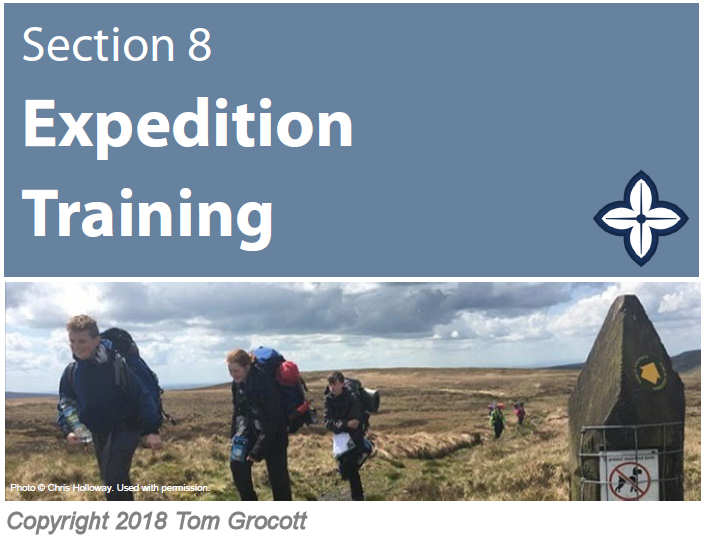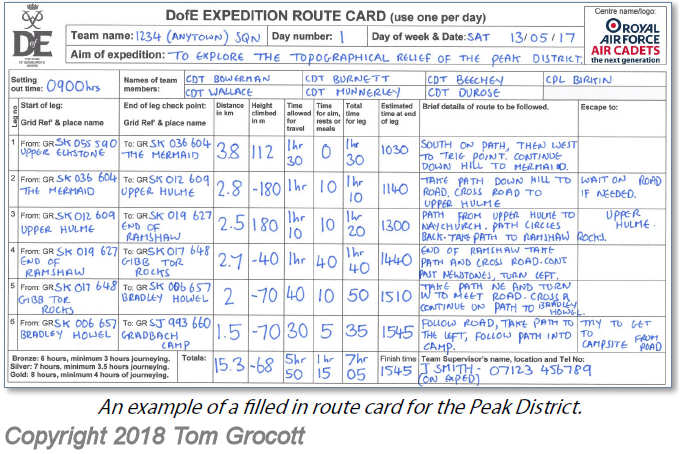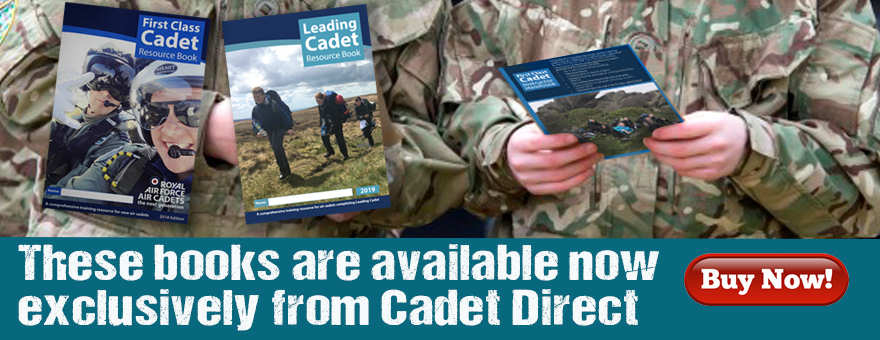Cadet Expeditions
The article below is an extract from the First Class Cadet Resource Book. Please note this information is subject to Copyright 2018 Thomas Grocott. Not for reproduction. Thomas Grocott has asserted his right to be identified as author of this work in accordance with the Copyright, Designs and Patents Act 1988. All rights reserved. Some images in this publication are Crown Copyright and contain public sector information licensed under the Open Government Licence v3.0.

LO1: Know how to plan and prepare for safe walking expeditions.
• Describe factors for consideration when planning a walking expedition.
• List the Countryside Code.
• Describe the purpose of a route card in a walking expedition.
• Identify how to prepare expedition equipment and clothing suitable for the walk being planned.
LO2: Be able to use tents and carry equipment safely.
• Demonstrate the erection of tents for a walking expedition.
• Demonstrate methods of kit packing for an expedition.
LO3: Understand the principles of safe camp craft on an expedition.
• Describe the principles of warmth and comfort in camp.
• Describe the essentials of siting, pitching and striking a camp.
• Explain food and cooking safety considerations for expeditions.
LO4: Recognise and treat the effects of hypothermia and heat excess.
• Explain the symptoms of hypothermia and heat excess.
• Describe how to treat hypothermia and heat excess.

Imagine that you are going walking in the Peak District with your friends. You could just wander about aimlessly for days wondering where you actually are, but it is a much better idea to plan your expedition before you set off. Planning is the most important part of an expedition and there are several things you need to consider before venturing out into the hills.
Expedition Considerations
• When planning an expedition you need to think about:
Length of the route
• Is the route long enough or is it too long? Duke of Edinburgh (DofE) routes must be a certain distance; this varies depending
on the level of award.
Type of ground you are covering
• Is the ground suitable terrain for an expedition? Planning a mountain expedition in tough, steep terrain, would not be appropriate for a DofE Bronze practice expedition.
• Check the environment is suitable for the time of year. Terrain that is easy to navigate in summer may not be in autumn or winter.
Weather Conditions
• Nearer the date of the expedition you will have a clearer idea of the actual weather But you should know certain things from
just the date. For example, during the winter it will be cold.
• It is important to check the weather and not be
Personnel Considerations
• When planning an expedition you also need to think about:
Age of the group
• Younger children and some older people are often not suited to long walks and challenging expeditions.
• Consider the group you have in order to make a good choice about the time of route.
Experience of the group
• Consider what experience your group has in different environments, a new group of cadets with no walking experience would not suit a tough
mountain day involving difficult conditions.
Fitness of the group
• When planning consider the fitness of the group as a whole. Consider everyone's ability, not just 1 or 2 people. If one person is unfit for a certain
route or area then the whole group will be unable to complete it.
• Always plan for the slowest person in a group and walk together as a team.
Number of people in the group
• DofE walking groups must have between 4 and 7 people in them.
• Outside of DofE groups can be smaller or larger.
• Consider the route you are going, is it appropriate for a large group? Narrow paths or steep slopes may not be suitable.
Summary
• Planning is the most important part of an expedition.
• Think about the length and type of route and look at the weather before you leave.
• Look at the age, experience, fitness and amount of people in the group whilst planning and make sure your walk is suitable for everyone.

The Countryside Code applies to all parts of the countryside in England and Wales, aiming to help everyone respect, protect and enjoy the outdoors. It is important to obey the countryside code at all times and follow the rules in its three sections:
Respect Other People
• Consider the local community and other people enjoying the outdoors.
• Co-operate with people at work in the countryside. For example, keep out of the way when farm animals are being gathered or moved and follow directions from the farmer.
• Leave gates and property as you find them and follow paths unless wider access is available.
Protect the Natural Environment
• Take special care not to damage, destroy or remove features such as rocks, plants and trees. They provide homes and food for wildlife, and add to everybody’s enjoyment of the countryside.
• Leave no trace of your visit and take your litter home. Litter and leftover food is ugly and can be dangerous to wildlife and farm animals
• Be very careful with naked flames and stoves. Avoid cooking on dry grass or vegetation. Fires can be as devastating to wildlife and habitats as they are to people and property.
Enjoy the Outdoors
• Plan ahead and be prepared.
• Wild animals, farm animals and horses can behave unpredictably if you get too close, especially if they’re with their young - so give them plenty of space.
• Check weather forecasts before you leave and be prepared to change plans, as weather can change quickly.
Summary
• Always follow the Countryside Code.
• More information can be found online.

Route Cards
A route card is used to help plan an expedition and is an integral part of the planning stage for a DofE Expedition. What is the Purpose of a Route Card?
• Structure for planning your day in the hills, including the route for staff and cadets. This is useful to keep yourself on track, and avoid being stuck
in darkness because you’ve taken too long to complete a route.
• Details of who's in the group and their emergency points of contact in case of a problem.
• Enable you to keep track of progress during the day. Approximate timings will help to give you an idea of position in case you get lost.
• Escape routes in case of emergency. These can be used if the weather dramatically changes or there is a major problem.
• A copy of your route and timings to allow staff to know where you should be, and keep track of your movements in case of a problem.
• An example of a filled in route card for the Peak District is displayed below. For an interactive route card visit: www.training.staffswing.org.uk/routecard


On an expedition you need the right kit to keep you warm, dry and comfortable. Being ill prepared makes for a miserable and potentially
dangerous expedition.
Packing a Rucksack
• Loading a bag correctly is all about weight distribution and making sure frequently used items are close at hand. Putting items in the correct place will make your bag much more comfortable to wear.
• Avoid attaching items to the outside of the rucksack.

For all expeditions, including even the most basic, you must have the following things with you:
Expedition Clothing
Waterproof Clothing
• Good waterproof clothing is important, it protects you from the wind and rain. Try and get a ‘breathable’ jacket. It lets sweat through but keeps wind and rain out.
• Try the jacket on with layers underneath. You may have to wear the jacket with other clothing.
Boots
• Boots must be comfortable and support your ankles. Trainers are not appropriate as they do not offer support or grip.
• Wear your boots before your expedition to get them to begin to mould to your foot. Make sure they fit by trying them on before you buy them.
• Some people like to wear their combat boots on expedition. If you do, make sure they are comfortable and in good condition.
Layered Clothing
• Layering clothing can help you keep the right temperature. You can add layers if you get too cold, and remove them if you are too hot:
• Base layers: Lightweight layer designed to allow sweat and body heat to pass freely.
Other Expedition Equipment
Rucksack
• Make sure that your rucksack is comfortable – most stores will let you try the rucksack with some weight in.
• Your rucksack should be around 65L for a bronze DofE expedition, any smaller and you may not be able to fit all your kit in.
• Male and female rucksacks are available which may be more comfortable.
Sleeping Bag
• A good sleeping bag will ensure you have a comfortable nights sleep while on expedition.
• Sleeping bags have a rating to tell you how warm they are, it will either have a season number from 1-4 or will state a temperature range. A 3
season bag will be suitable for most expeditions. 4 season bags are for year round use but are often bulkier and more expensive.
You will also need;
• A personal first aid kit in case of injury.
• A roll mat or inflatable mat. This insulates you from the cold ground whilst camping.
• A tent. This is usually a group item. You will spread the weight between your group by carrying part of the tent.
• A map and compass is essential for navigation whilst on expedition. It is important to keep the map dry by using a map case.
Summary
• Ensure you are properly equipped for your expedition.
• Ask to borrow equipment from your squadron or other people to save money.
• Packing your rucksack properly will mean you are more comfortable and can get to essentials quickly.
The article above is an extract from the First Class Cadet Resource Book. Please note this information is subject to Copyright 2018 Thomas Grocott. Not for reproduction. Thomas Grocott has asserted his right to be identified as author of this work in accordance with the Copyright, Designs and Patents Act 1988. All rights reserved. Some images in this publication are Crown Copyright and contain public sector information licensed under the Open Government Licence v3.0.



